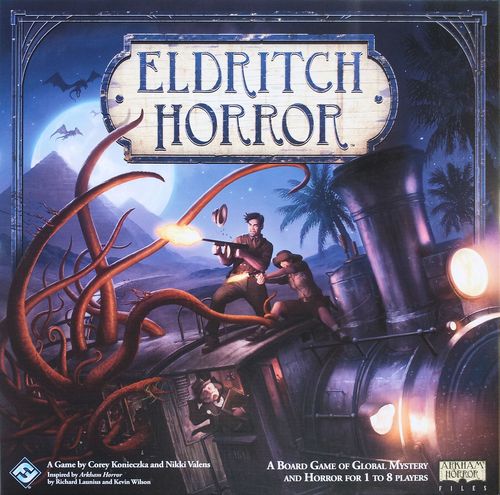
Eldritch Horror - Review and a bit of Statistics
| Game | Eldritch Horror |
|---|---|
| Publisher: | Fantasy Flight Games |
| Year: | 2013 |
| Category: | Cooperative, World Map |
| Priamry Mechanics: | Compounding Loss, Character Improvement |
| Times played by reviewer: | 5 |
| Board Game Geek: | link |
Eldritch Horror (EH) is a heavily reviewed game from a major publisher. Others have provided comprehensive reviews and videos of the rules and gameplay, so this review will focus on the theme and a few of the mechanics that both play into the theme as well as cause some major problems for me.
EH is a cooperative, world spanning game where investigators team up to solve 3 mystery card conditions (not actually a mystery or puzzle) before the coming of a big bad Great Old One from the Lovercraftian mythos. The game is a mash up Arkahm Horror and 2008 hit Pandemic.
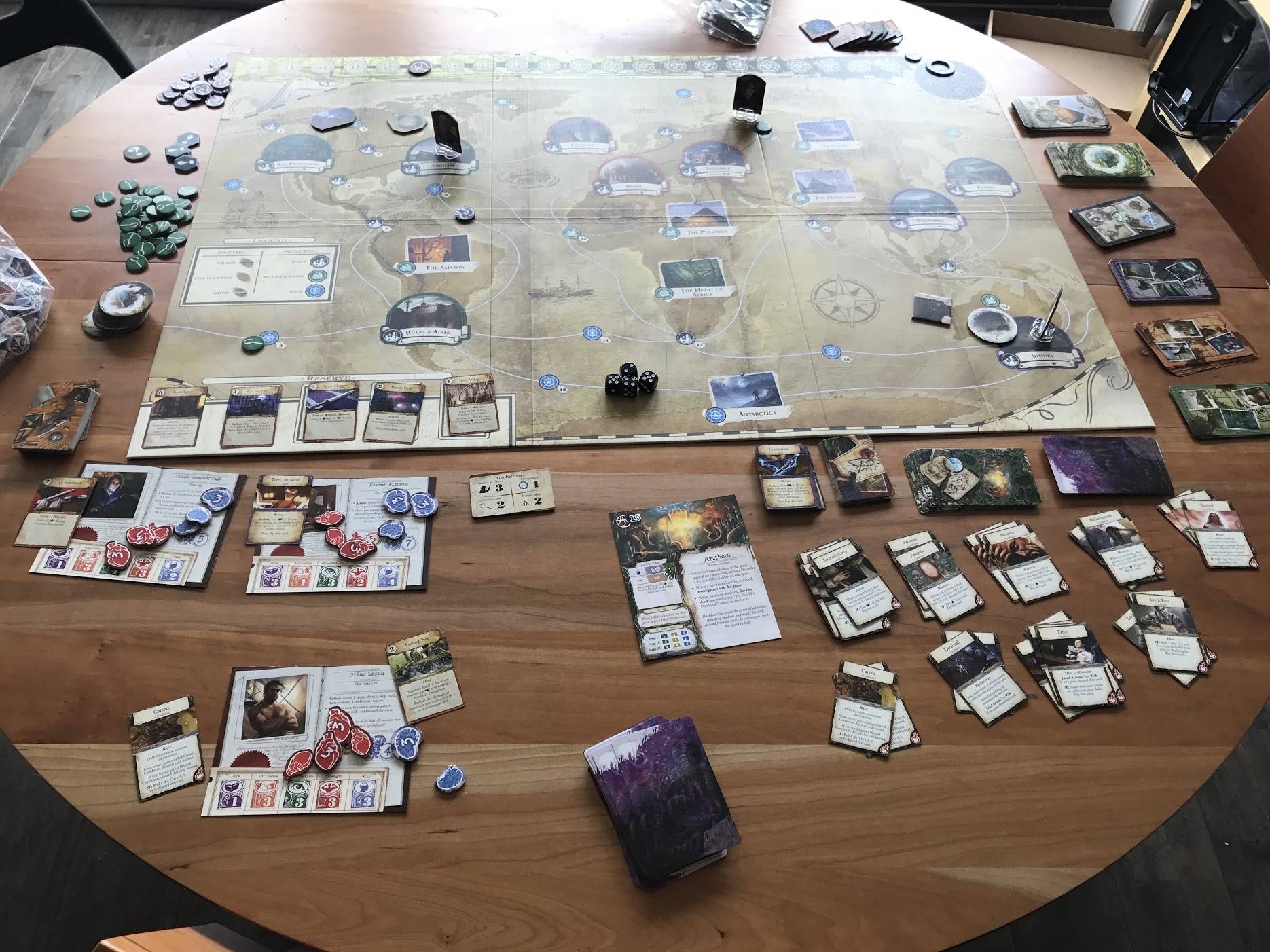
A set up to battle the coming of Azathoth
Theme
I was excited to play this game because of the obvious parallels to an all time favorite of mine, Masks of Nyarlathotep. Fantasy Flight Games turned its city-sized cooperative Cthulhu experience, Arkham Horror, into an epic globetrotting, monster-bashing, insanity-inducing affair. Masks is a true ‘best-of’ 80’s role playing and was my first exposure to Lovecraft. A board game evoking its magic was always going to get attention from me and like-minded Cthulhu fans.
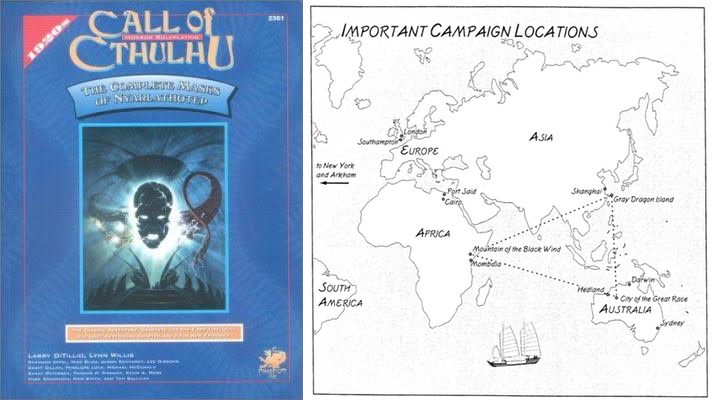
1989's Masks of Nyarlathotep brought many first time investigators to dudes-on-a-map scale fun
Cards in EH all have excellent thematic “read this” text weaving a story for the investigator’s travels and encounters. Many types of cards exist in multiples where the front of the card is visible to the player, but the back of the card is a mystery until flipped, often containing negative consequences for not dealing with something in a timely manner. As a result, when a character racks up Debt improving one’s character they don’t know if they’ve thrown in with vengeful 20’s mob bosses or gotten a bit over-leveraged with the local blood-thirsty cultist lodge. All this plays well into the theme of a Call of Cthulhu like game where you are fighting the unknown. Unlike other cooperative game you are meant to have a limited understanding of your enemies and obstacles. Being able to memorize all cards and conditions to beat the game would work counter to the theme and introduce meta-thinking into a world where the unknowable is supposed to be and remain the biggest threat.
Mechanics
Character Improvement vs. Environment
Characters in EH have heavy RPG elements from health and sanity counters to inventories of equipment and spells. Improving base stats that play into a character’s specialist role in the game, whether it be monster basher or clue finder is an important part to improving chances of defeating this very difficult game. The rolling mechanic and stat improvements are important to mention for reasons I’ll get into in the next section. To test a stat in an encounter or fight a monster, a player rolls a number of six sided dice equal to their stat looking for at least one success. A success is a roll of 5’s or higher on a standard six sided die. With a good handful of dice, let’s say 4, that means the probability of passing a simple test is above 80%
probability of having at least 1 success on 4 dice = probability of not having 4 consecutive failures = 1 - P(fail)^4 = 1 - (4/6)^4 = 80.2%
The problem for the player is that encounters are random and test an unknown sampling of five stats. Areas list what the likely outcome of a success will grant the player, for example choosing an encounter in Arkham, MA tends to result in spells where encounters in Tokyo tend to clear monsters from the board, but the skills tested by the encounter are unknown.
Monsters stats are not known until they are encountered, but some amount of universe knowledge, memorization, or the epic designation for some monsters give players a good clue as to how difficult they will be to face. The problem is that defeating monsters means accumulating enough successes to overcome the monster’s toughness value. Hard monsters not only have higher toughness but also apply penalties to player’s combat dice pool. As a result clearing a monster from the board has some risk to it. I’ll spare you the binomial math nCr example, but combat outcomes are non-deterministic and risky, especially if you didn’t memorize all the monsters.
As a result engaging in in encounters and monster combat looks like the following
Encounter: Unpredictable player outcome vs. predictable reward Monsters: Unpredictable player outcome vs. known reward
Compounding Doom
In EH, there is a Doom track that counts down to the end of the world when the stars are right and the specific Lovecraftian Big Bad awakens or returns to the Earth to destroy it. This is a theme heavy game, so each step along that path has excellent card text that players should be encouraged to read aloud. Encounters, monsters, Mythos cards all start creating situations where the steps in the doom track will count down at a ever faster rate.
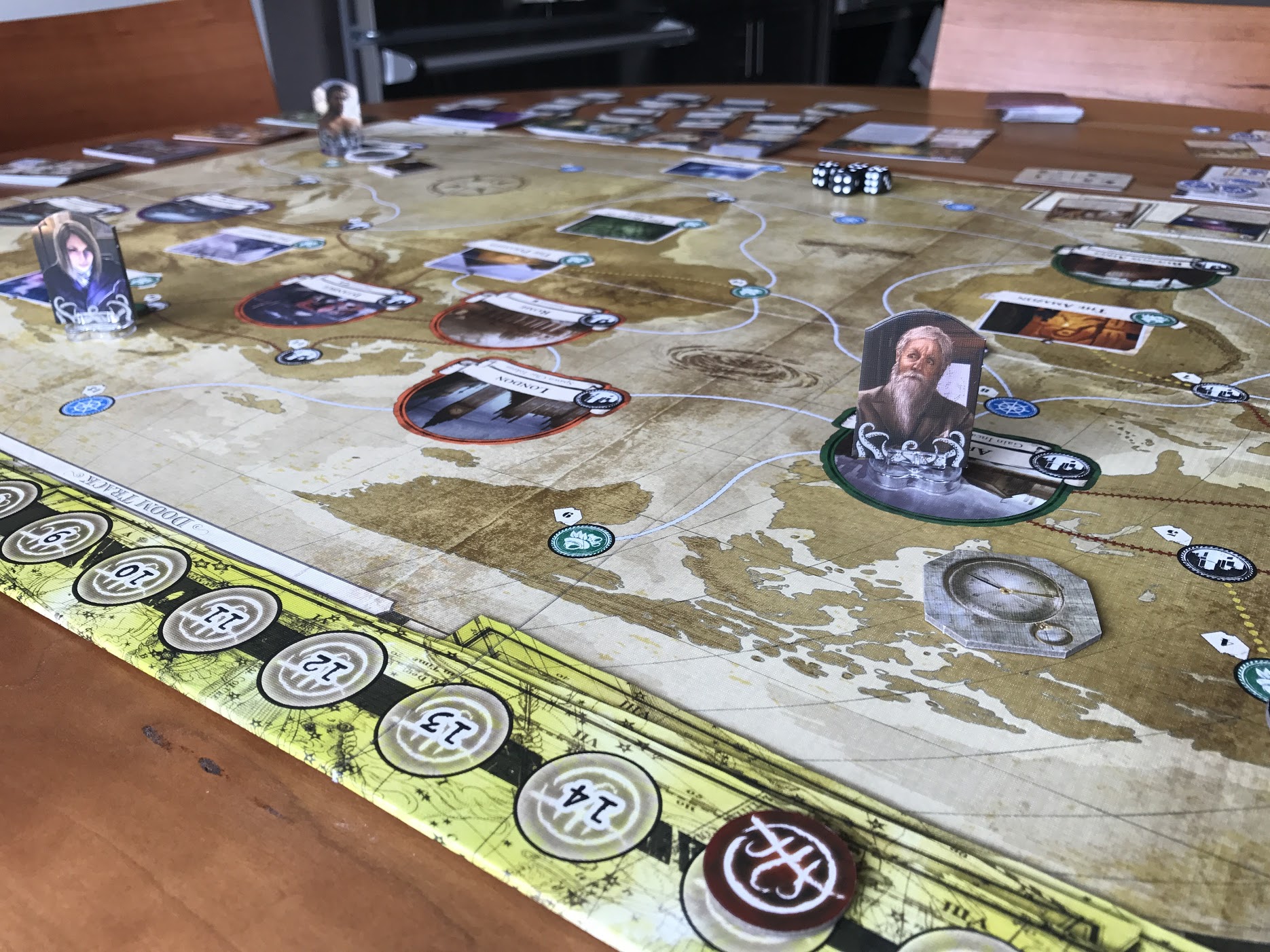
The professor looks worryingly at doom track at the beginning of the game. He may be the only investigator who knows how bad it is about to get.
The primary risk to investigators in EH is similar to that in Pandemic. In Pandemic, untreated infections can cascade across borders in a way that roughly simulates compounding infection rates. Players have to decide how much of their joint actions are spent working to cure disease vs. treat the infections before they spread out of control. Here’s a video of a randomly drawn cascading infection playing out in a video game version of Pandemic:
Compounding infection mechanic in Pandemic, iOS Version by Asmodee Digital
The problem is that too much is random in EH. They joy of Pandemic is that the player’s ability to stamp out infection, especially that of the Medic character, is completely deterministic. A player willing to travel and spend the points to cure an infection is guaranteed to have an impact. The only random risk is that the city with an existing infection will be the randomly chosen next point for infection spread and eventual border-crossing outbreak. In short:
Pandemic treating illness: Deterministic player outcome vs. unpredictable benefit
Unfortunately cold hard science has little impact on Great Cthulhu.
In EH, characters fight monsters with dice rolls using fallible abilities like spells. They roll their hopefully improved stats against branching encounter text to prevent the doom track from accelerating. The advancement of the doom track is also randomized as players don’t know what’s coming in the mythos or mystery decks, which means in Eldritch horror layers are faced with the following mechanic:
Actions to prevent doom: Unpredictable outcome vs. unpredictable benefit
The game becomes random “bad stuff happens” vs. random player outcomes and as a result removes all sense of player agency. Playing smart involves moving quickly and beating the game as fast as possible so as to avoid encountering all the great thematic content which is there to hinder and kill you (god help you if the Great Old One card flip).
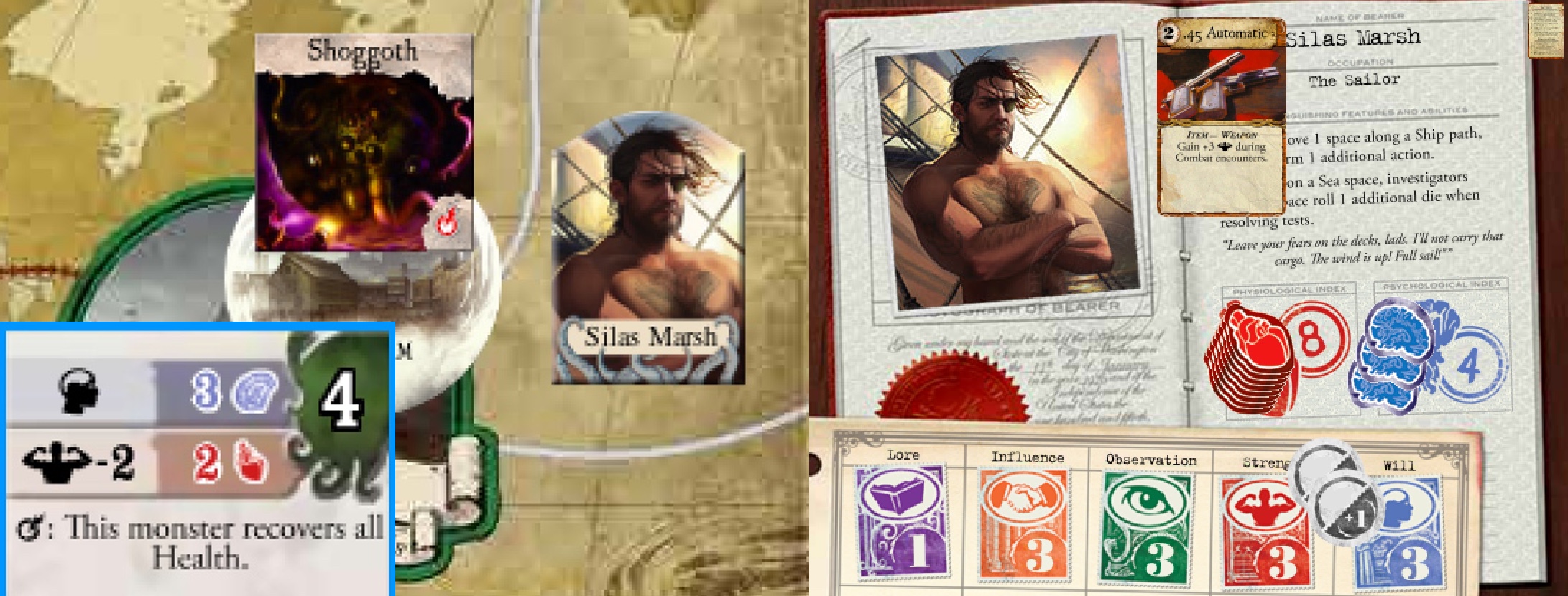
Silas vs Shoggoth
Okay, I lied. Here’s the math. Imagine Silas Marsh is has to close the gate under the Shoggoth in order to solve a mystery or stop the doom track from advancing. To emphasize the uncertainty of his situation, he has to kill the Shoggoth first in order to earn the right to then have an uncertain chance to close the gate and stop the end of the world.
In this example Silas is down by one point of sanity but has a combat role of 8 with his +2 skill improvement and +3 weapon. The Shoggoth has a risk of 3 SAN damage and requires 4 combat successes to kill in this turn. If the Shoggoth isn’t completely killed there is a good chance it will heal all the way back to 4 health during the mythos phase, effectively wasting the player’s turn.
The math here is called a binomial distribution. The chance of rolling exactly k successful trials with n attempts when the independent chance of trial success is p can be expressed as P(k,n,p) = (n choose k) * p^k * (1-p)^(n−k). P is computed in Excel using the BINOMDIST() function. Doing that and summing all the probabilities for kill and overkill yields the following
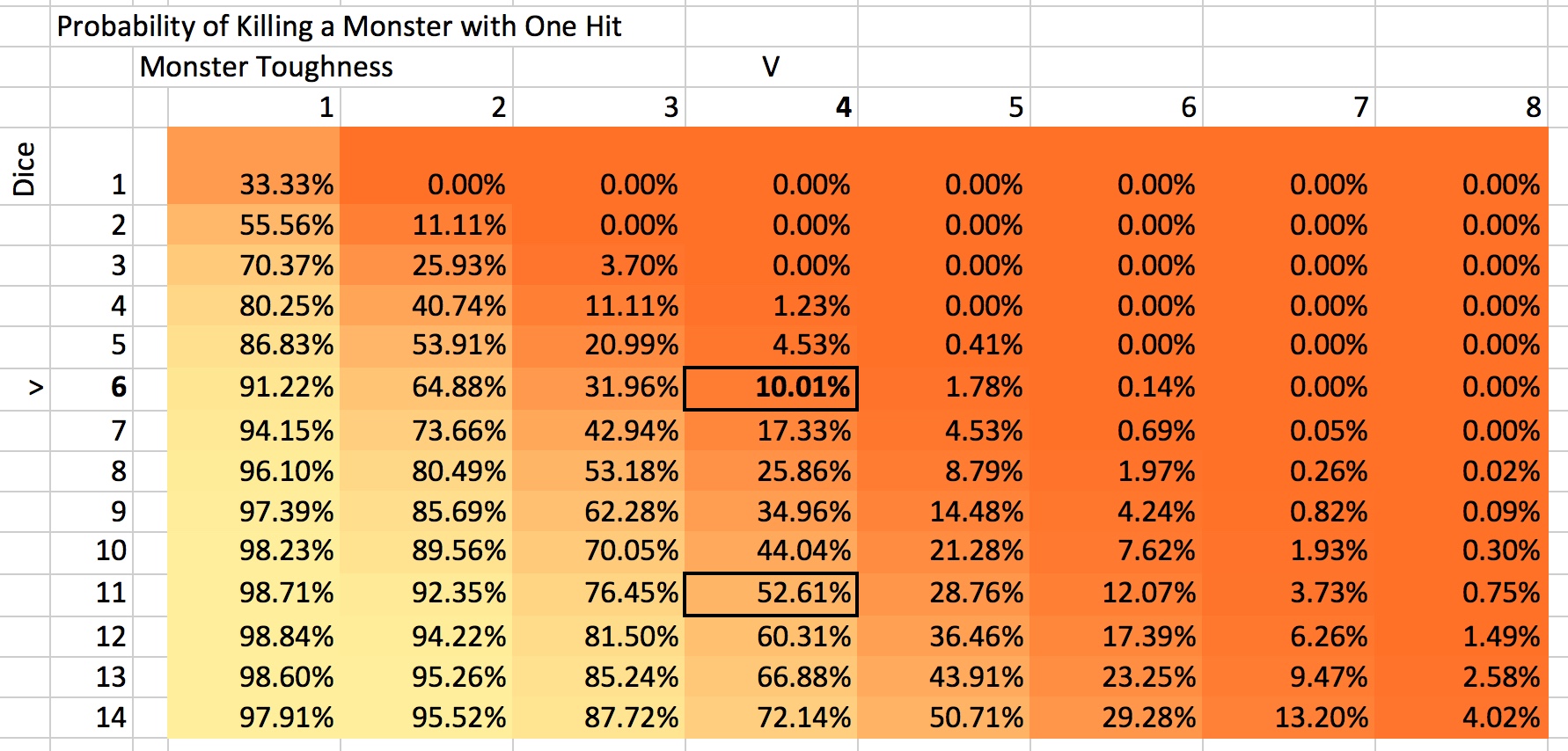
Binomial probability
Silas rolls only six dice against the monster hoping for four successes. That gives him only a ten percent chance of progressing the story. Incidentally Silas also has a 29% chance of getting no successes on his sanity roll and getting taken out of the game all together. Even if Silas was immune to the monster he wouldn’t have above a 50% chance of getting to that gate this round unless he amassed the equivalent of 13 combat dice. For some reason the game only comes with 4 dice. Did I mention this game was hard?
It could be said this is in keeping with the theme. Player agency isn’t a big part of the Lovecraftian world, where investigators are supposed to feel hopeless in the face of an uncaring, entropic universe. TPKs were always a risk in Masks of Nyarlathotep. The game just finds more ways to hammer it in. The Mystery Deck, aka the ‘Bad Things Happen™’ deck, has a number of action denial or outright game losing cards that can make players feel robbed of the amount of time they sat down to play this game. Which leads to the next topic …
Setup and Play Time Problems
Eldritch Horror takes at least 15 minutes to set up if you havn’t made a custom organizer to leave your game box in a game ready state. Assuming 10 minutes to clean up and an hour of play time per investigator, that’s a three to four hour commitment. If I suggest it at a game night, it will likely be the only game my group plays.
The game has a comical number of card stacks and chit categories especially if one keeps the condition categories separate. While the game is theme heavy and realistically simulates something like Masks, which took us an entire semester in college to get through, imagine the frustration of having a game-ending mythos deck card come out knowing that all that setup, pizza ordering, and time spent organizing a game together was all brought down not by something outside of your control. The game is hard, yes. But on top of that, EH it is punishing to those who attempt to beat it. The game has great replay potential, but honestly, playing feels sisyphean if each attempt can be thwarted by contents of a single Mythos card.
Fortunately there is an excellent Vassal board game module for Eldritch Horror. It may be only an urban legend that FFG doesn’t mind this existing as long as the backs of some cards types are omitted so that players have to refer to their physical copies, but it seems like a fair system. I’ve played a number of solo-games and being able to pause and avoid setup and clean up time helps immensely.
Final Thoughts
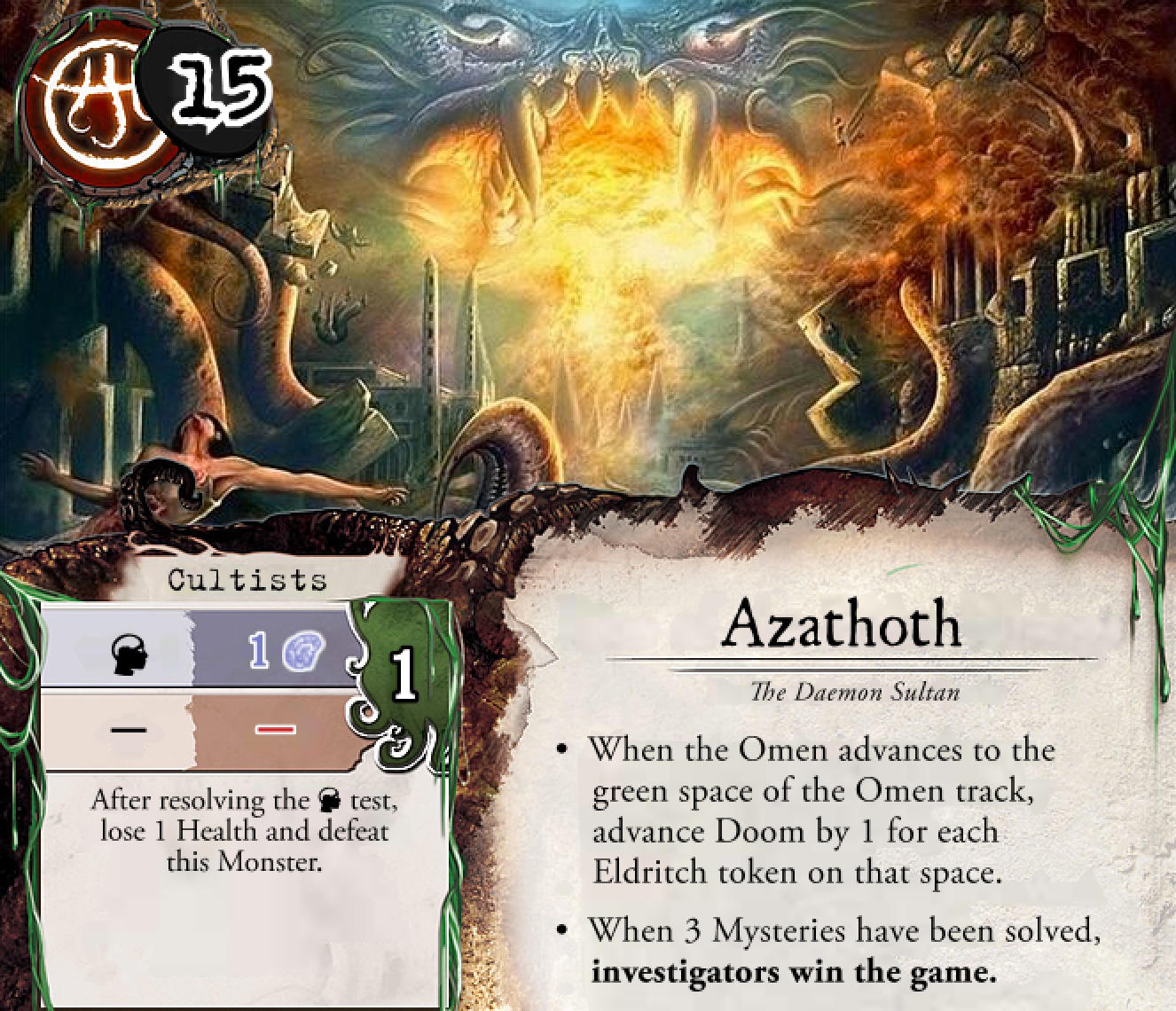
Azathoth, see the resemblance?
Clearly, in theme this is a game feels like it was made just for me and like minded Lovecraft fans. One of the great old one’s is even related to the name of my general gaming handle and name of this blog, Azathought. The long play time and lack of agency however means it is rarely going to come off of my shelf and I am unlikely to ever attempt beating its supposedly tougher Old Ones or expansions. I encourage people playing the game to “embrace the suck.” If the players believe they have control over the outcome of a play of Eldritch Horror, they are fooling themselves in the best traditions of Lovecraftian protagonists but at the cost of a fun board game. As the game reminds us, our time on earth is limited, so I’ll probably be spending it with other Lovecraftian games. I hear The Arkham Horror Card Game is good. Maybe I’ll check that out next.
Thanks for reading.